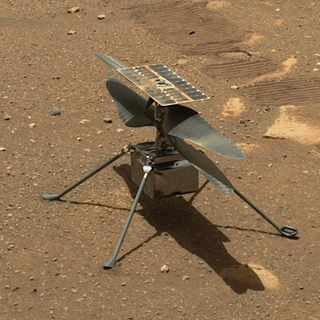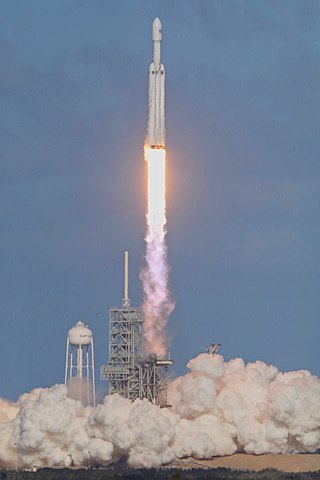Related Research Articles
Human spaceflight programs have been conducted, started, or planned by multiple countries and companies. Until the 21st century, human spaceflight programs were sponsored exclusively by governments, through either the military or civilian space agencies. With the launch of the privately funded SpaceShipOne in 2004, a new category of human spaceflight programs – commercial human spaceflight – arrived. By the end of 2022, three countries and one private company (SpaceX) had successfully launched humans to Earth orbit, and two private companies had launched humans on a suborbital trajectory.

The Space Age is a period encompassing the activities related to the space race, space exploration, space technology, and the cultural developments influenced by these events, beginning with the launch of Sputnik 1 on October 4, 1957, and continuing to the present.

Private spaceflight refers to spaceflight activities undertaken by non-governmental entities, such as corporations, individuals, or non-profit organizations. This contrasts with public spaceflight, which is traditionally conducted by government agencies like NASA, ESA, or JAXA.

Space Exploration Technologies Corp., commonly referred to as SpaceX, is an American spacecraft manufacturer, launch service provider, defense contractor and satellite communications company headquartered in Hawthorne, California. The company was founded in 2002 by Elon Musk with the goal of reducing space transportation costs and ultimately developing a sustainable colony on Mars. The company currently operates the Falcon 9 and Falcon Heavy rockets along with the Dragon and Starship spacecraft.

Vertical takeoff, vertical landing (VTVL) is a form of takeoff and landing for rockets. Multiple VTVL craft have flown. The most successful VTVL vehicle was the Apollo Lunar Module which delivered the first humans to the Moon. Building on the decades of development, SpaceX utilised the VTVL concept for its flagship Falcon 9 first stage, which has delivered over two hundred successful powered landings so far.

SpaceX has stated its ambition to facilitate the colonization of Mars via the development of the Starship launch vehicle. The company states that this is necessary for the long-term survival of the human species.

A super heavy-lift launch vehicle is a rocket that can lift to low Earth orbit a "super heavy payload", which is defined as more than 50 metric tons (110,000 lb) by the United States and as more than 100 metric tons (220,000 lb) by Russia. It is the most capable launch vehicle classification by mass to orbit, exceeding that of the heavy-lift launch vehicle classification.

Jim Cantrell is an American entrepreneur, mechanical engineer and road racer. He is the CEO and co-founder of Phantom Space Corporation, which aims to build space transportation technology. After working at the French Space Agency CNES and the NASA Jet Propulsion Lab, he worked as an independent consultant to aerospace companies for fifteen years and was on the founding teams of SpaceX and Moon Express. Cantrell was SpaceX's first vice president of business development and Elon Musk's industry mentor when SpaceX launched in 2002.

The billionaire space race is the rivalry among entrepreneurs who have entered the space industry from other industries - particularly computing. This private spaceflight race involves sending privately developed rockets and vehicles to various destinations in space, often in response to government programs or to develop the space tourism sector.

This is a corporate history of SpaceX, an American aerospace manufacturer and spacetransport services company founded by Elon Musk.

The year 2021 broke the record for the most orbital launch attempts till then (146) and most humans in space concurrently (19) despite the effects of COVID-19 pandemic.
The future of space exploration involves both telescopic exploration and the physical exploration of space by robotic spacecraft and human spaceflight.

The Falcon Heavy test flight was the first attempt by SpaceX to launch a Falcon Heavy rocket on February 6, 2018, at 20:45 UTC. The successful test introduced the Falcon Heavy as the most powerful rocket in operation at the time, producing five million pounds-force (22 MN) of thrust and having more than twice the payload capacity of the next most powerful rocket, United Launch Alliance's Delta IV Heavy.

Starship is a two-stage super heavy-lift launch vehicle under development by SpaceX. It is the largest and most powerful rocket ever flown. Starship's primary objective is to lower launch costs significantly via economies of scale. This is achieved by reusing both rocket stages, increasing payload mass to orbit, increasing launch frequency, creating a mass-manufacturing pipeline, and adapting it to a wide range of space missions. Starship is the latest project in SpaceX's decades-long reusable launch system development program and ambition of colonizing Mars.

The Artemis program is a Moon exploration program that is led by the United States' NASA and was formally established in 2017 via Space Policy Directive 1. The Artemis program is intended to reestablish a human presence on the Moon for the first time since Apollo 17 in 1972. The program's stated long-term goal is to establish a permanent base on the Moon to facilitate human missions to Mars.

Raptor is a family of rocket engines developed and manufactured by SpaceX. The engine is a full-flow staged combustion cycle (FFSC) engine powered by cryogenic liquid methane and liquid oxygen ("methalox").

Starship HLS is a lunar lander variant of the Starship spacecraft that is slated to transfer astronauts from a lunar orbit to the surface of the Moon and back. It is being designed and built by SpaceX under the Human Landing System contract to NASA as a critical element of NASA's Artemis program to land a crew on the Moon.
A floating launch vehicle operations platform is a marine vessel used for launch or landing operations of an orbital launch vehicle by a launch service provider: putting satellites into orbit around Earth or another celestial body, or recovering first-stage boosters from orbital-class flights by making a propulsive landing on the platform.
References
- ↑ Cheryl Werber (18 September 2016). "Could NASA Lose Mars Race to SpaceX?". CDA News. Archived from the original on 22 May 2017. Retrieved 7 October 2016.
- 1 2 Alexis Christoforous (13 March 2017). "Here's how you can profit from the race to Mars". Yahoo Finance.
- ↑ "Game On! Boeing Wants to Beat SpaceX in the Race to Mars". Nature World News. 6 October 2016.
- ↑ "Elon Musk and a Boeing Rocket Are in a Race for Mars". The Kindland. 5 October 2016.
- ↑ Ben Rosen (10 October 2016). "Did Boeing's CEO just kick off a billionaires' space race?". Christian Science Monitor.
- ↑ Irene Klotz (1 November 2016). "NASA: We're Not Racing SpaceX to Mars". Seeker. Space.com.
- ↑ Emily Marks (20 October 2016). "NASA Joins SpaceX And Boeing On The Race To Mars". University Herald.
- ↑ Darlene Superville (21 March 2017). "Trump Wants to Send Humans to Mars". U.S. News & World Report. Associated Press.
- ↑ Ron Duwell (22 March 2017). "NASA's new goal of getting to Mars by 2033 set by President Donald Trump". TechnoBuffalo. Archived from the original on 4 October 2018. Retrieved 8 April 2017.
- ↑ Julie Johnsson (4 October 2016). "Boeing CEO Vows to Beat Musk to Mars". Bloomberg.
- ↑ Eric Berger (5 October 2016). "Boeing CEO jabs SpaceX, says Mars explorers will ride his rocket". Ars Technica.
- ↑ Jamie Condliffe (5 October 2016). "The 21st-Century Space Race: Will Boeing or SpaceX Be First to Mars?". MIT Technology Review.
- ↑ Emily Marks (14 October 2016). "Boeing May Beat SpaceX To Mars And Elon Musk Is Fine With It". University Herald.
- ↑ Alan Boyle (27 September 2016). "Jeff Bezos' Blue Origin space venture sets its sights on trips to Mars and the moon". Yahoo News.
- ↑ Nick Stockton (13 September 2016). "Jeff Bezos' New Rocket Could Send The First People To Mars". Wired.
- ↑ Doug Mohney (29 September 2016). "SpaceX and Blue Origin Talk Seriously Going to Mars". Tech Zone 360.
- ↑ Danica Lo (3 October 2016). "Richard Branson Wants to Build Hotels in Space". FoodAndWine.com.
- ↑ Miriam Kramer; Jessica Plautz (2015-11-06). "Sir Richard Branson wants to colonize Mars, but he's willing to share". Mashable.
{{cite web}}: CS1 maint: multiple names: authors list (link) - ↑ "Richard Branson on space travel: "I'm determined to start a population on Mars"". CBS News. 18 September 2012.
- ↑ Henry, Caleb (24 October 2019). "Virgin Orbit to add extra rocket stage to LauncherOne for interplanetary missions". SpaceNews . Retrieved 31 August 2021.
- ↑ O'Callaghan, Jonathan (9 October 2019). "Virgin Orbit Is Planning An Ambitious Mission To Mars In 2022". Forbes . Retrieved 31 August 2021.
- ↑ spacexcmsadmin (2016-09-20). "Mars". SpaceX. Retrieved 2018-10-17.
- ↑ Torchinsky, Rina (17 March 2022). "Elon Musk hints at a crewed mission to Mars in 2029". NPR .
- ↑ "Starship's Third Flight Test". SpaceX. Archived from the original on March 6, 2024. Retrieved 2024-03-14.
- ↑ Chris Cooper; Kiyotaka Matsuda (29 November 2016). "The U.S. and China Are Fighting Over Mars, but Japan May Win the Space Race". Bloomberg.
- ↑ Jacob Brogan (6 April 2017). "What Slate Readers Think About the New Space Race". Slate.com.
- ↑ Are We Losing the Space Race to China?. Space Subcommittee Hearing. United States House of Representatives. 27 September 2016.
- ↑ Clay Dillow (28 March 2017). "China's secret plan to crush SpaceX and the US space program". CNBC.


